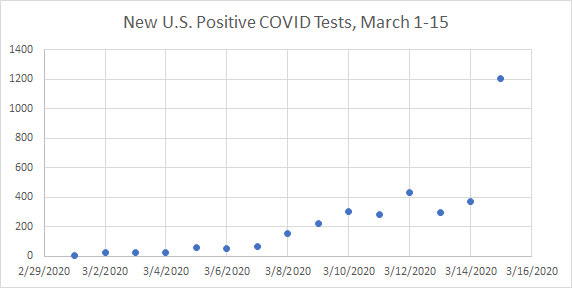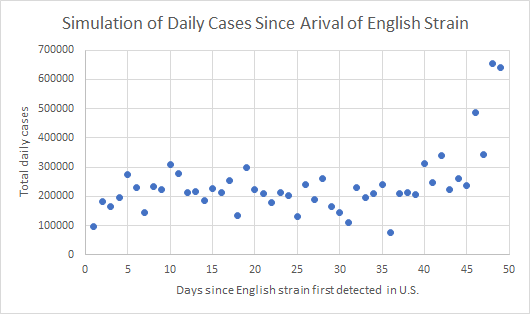Overall numbers won't show the English strain coming
post by Eric Neyman (UnexpectedValues) · 2021-01-01T23:00:34.905Z · LW · GW · 12 commentsContents
12 comments
[Epistemic status: half-baked thoughts that might be wrong. Apologies if this point has already been made.]
[Edit: here's a version of this post that is meant for a more general audience.]
Here is a plot of daily new positive COVID tests in the U.S. in the first half of March 2020.

While the rationalist community figured out the whole exponential growth thing in February, it's no surprise that the general public was worried by mid-March: the virus was here and was growing fast. This was evident by the time there were 1,000 new positive tests per day. The lockdown began around mid-March, which is way worse than if it had begun in early March, but much, much better than if it had begun in late March, by which time we had tens of thousands of new positive tests per day.
The situation with the English strain is different. One way in which it's better is that we now have adequate testing. But there's a scary way in which it's worse.
The reason that the chart above is scary is because on any given day there were many times more cases than just a week before. I won't cherry-pick March 15th, but e.g. on March 12th there were 7 times more cases than on March 5th. And the reason that this trend was so evident is that the exponential growth drowned out any day-to-day noise.
This won't be the case with the English strain, at least if the general public (or public officials) use overall numbers to guide their planning. That's because, instead of seeing an exponential trend, i.e. something like plus noise, we'll be looking at something like plus noise (where 200,000 is the currently dominant strain and 1.3^t is the contribution from the English strain). Here's a simulation of what that looks like if the noise is normal with standard deviation 25%.

Remember that people starting freaking out about COVID around when there were 1,000 new positive tests per day. So here's my question: where on this chart does the English strain first contribute 1,000 new positive tests per day? The answer:
Day 27
On the other hand, I don't think the general public will start worrying about the new strain until it starts adding to the overall numbers substantially, i.e. sometime between day 40 and day 50.
This means that, because there's already a high baseline case count (plus noise), I expect the general public's reaction time to lag by two or three weeks. (Edit: it's no complicated and I no longer stand by this particular number -- though I stand by the overall point. See the edit at the bottom of my post.)
Now, there are factors going in the other direction:
- We are testing way more, so "1000 positive tests" now isn't a fair comparison to "1000 positive tests in March".
- We're already exercising our quarantine muscles. We won't have to re-learn everything (e.g. "wear masks") from scratch.
At the same time, one reason to expect people to react less is that COVID isn't a scary new thing; it's already here, seemingly a known quantity.
But in any case, I think there's reason to expect our reaction to the English strain to be slower, and that's pretty scary.
(EDIT: Bucky correctly points out [LW(p) · GW(p)] that the constant 1.3 is too large. I've made an attempt [LW(p) · GW(p)] to correct for that, though I'm no longer sure how to directly compare this situation to March.)
12 comments
Comments sorted by top scores.
comment by Dagon · 2021-01-02T00:15:59.753Z · LW(p) · GW(p)
our reaction to the English strain to be slower
Seems very likely. And given our insufficient reaction to the initial strains, it's likely that our reaction will remain insufficient.
That said, going from 0 to bad was both a much harder thing to accept and a clearer actual reaction than going from bad to worse. It's not clear what the proper reaction to the English strain is, other than what we should have been doing all along.
Replies from: ChristianKl, BellLongworth↑ comment by ChristianKl · 2021-01-02T12:54:52.012Z · LW(p) · GW(p)
It's not clear what the proper reaction to the English strain is, other than what we should have been doing all along.
Switching the RNA of Moderna/BionTec vaccines to match the coding of the spike protein in the English strain (or a mix of different strains) might be a worthwhile move.
While I'm not certain (maybe our existing vaccines are good enough) it might be a good idea to run clinical trials for it.
↑ comment by BellLongworth · 2021-01-02T09:12:29.501Z · LW(p) · GW(p)
It's not clear what the proper reaction to the English strain is, other than what we should have been doing all along.
There is a spectrum of responses. We can start lockdowns a week earlier, enact stricter policies, put more effort on efficient vaccination.
For example, Israel gets a lot of good press for its fast vaccination program. While I'm sure good organization is the main contributor to their success, I believe there is also a strong external contributing factor: The second half of December is not a holiday season in Israel.
Could Europe and the US have moved to war footing in mid-December and not allowed the holidays to slow down their vaccination work? Yes.
Replies from: ejacob, ChristianKl, Dagon↑ comment by ejacob · 2021-01-02T19:10:13.394Z · LW(p) · GW(p)
Israeli vaccinations run 24/7, even on Shabbat, which would normally prohibit most of the tasks involved with an organized vaccination effort (e.g.: driving, writing). The decision to vaccinate on shabbat is in fact endorsed by most of the more religious aspects of the society since saving lives is a sort of prime directive in Judaism that overrides other concerns in most situations.
All this is simply to say that I think that even if December was a holiday season in Israel, they would likely have made similar progress by now, simply because the culture and government is okay with suspending normal behavior for emergencies (a product of having an emergency every week or so for the last 70-odd years + the religious quirk). Compare to the US where vaccinations took Christmas off while doses sat on the shelf...
Could Europe and the US have moved to war footing in mid-December and not allowed the holidays to slow down their vaccination work? Yes.
Yes, yes indeed!
↑ comment by ChristianKl · 2021-01-02T13:11:32.099Z · LW(p) · GW(p)
Could Europe and the US have moved to war footing in mid-December and not allowed the holidays to slow down their vaccination work?
The better question would be whether they could have started their vaccination work at the end of November.
↑ comment by Dagon · 2021-01-02T17:42:30.123Z · LW(p) · GW(p)
Agree with all of those actions. None are responses to the English strain, they are all things we've horrifically failed to do already.
Christian's comment about modifying and testing vaccines is a good one. I very much hope that, since this doesn't require much public agreement, it's happening in competent labs across the world.
comment by Bucky · 2021-01-02T13:59:52.189Z · LW(p) · GW(p)
Is there a reason for 1.3 per day? This seems very fast (like the beginning of the outbreak before we were taking any containment measures).
If the old strain is R=1 then we expect the new strain to be say R=1.65. This would mean (given generation time of 6.5 days) that the 1.3 would change to1.08.
Each 2 days in your analysis would be equivalent to about a week in the 1.08 model.
Replies from: UnexpectedValues↑ comment by Eric Neyman (UnexpectedValues) · 2021-01-02T18:31:52.226Z · LW(p) · GW(p)
Yeah, you're right. 1.3 was the right constant for Covid in March because of a combination of not being locked down and having more and more tests. This was my attempt to make a direct comparison, but maybe the right way to make that comparison would be to say "if R=1.65 (which I'll trust you that it leads to a constant of 1.08), we will react about X days slower than if we started from scratch."
What is X? The answer is about 60 (two months). On the one hand, that's a lot more than the 2-3 weeks above; on the other hand, it's less scary because R is lower.
Replies from: Bucky↑ comment by Bucky · 2021-01-02T23:11:39.514Z · LW(p) · GW(p)
Yes, that was my conclusion too.
I get the impression that the US response is best modelled on how much action individuals choose to take based on how scared they feel / how fed up they are with COVID restrictions.
In the UK I think people’s response is generally more directly linked to the government’s rules and guidance (with a fair bit of going slightly beyond the rules and a little bit of completely ignoring them).
In the latter case things can be put in place before the 60 day delay (for instance Scotland didn’t have many cases of the new strain but took drastic action despite that because they knew it would grow quickly). In the former case I think your description here is a good model of the response - we could slow it down by reacting early but we probably won’t.
comment by avturchin · 2021-01-02T17:28:23.405Z · LW(p) · GW(p)
In some states the spread of the British variant will be obvious earlier, and it could be observed as double peak on charts.
The situation in the UK could be also informative. There are 57K cases today in UK.
Replies from: UnexpectedValues↑ comment by Eric Neyman (UnexpectedValues) · 2021-01-02T18:43:32.395Z · LW(p) · GW(p)
That's true. My response is that if I recall correctly, people didn't seem to react very strongly to what was happening in Italy a couple weeks before it was happening here. So I'm not sure that a surge in the UK would inform the US response much (even though it should).
Replies from: avturchin↑ comment by avturchin · 2021-01-02T19:44:39.290Z · LW(p) · GW(p)
Ireland also exploded. https://www.worldometers.info/coronavirus/country/ireland/
I would watch NY and CA.